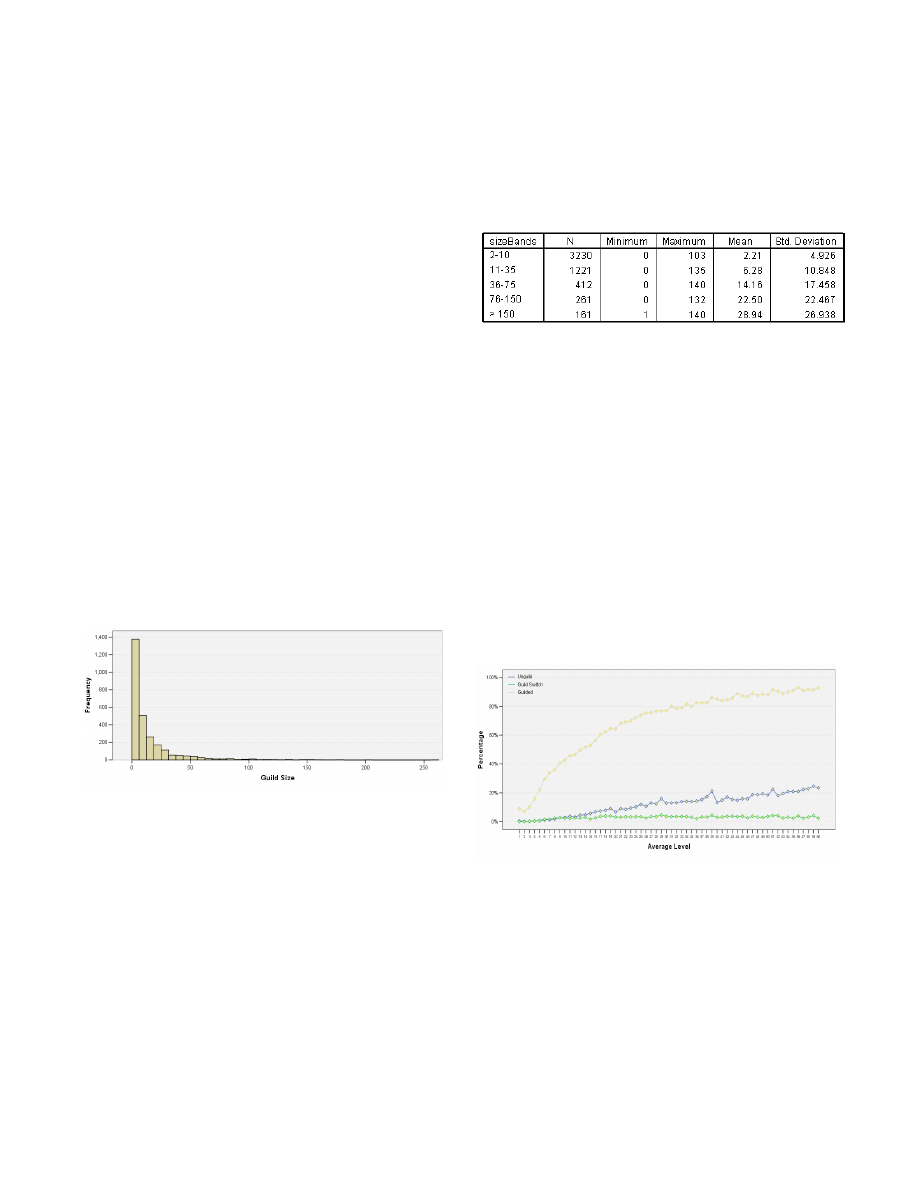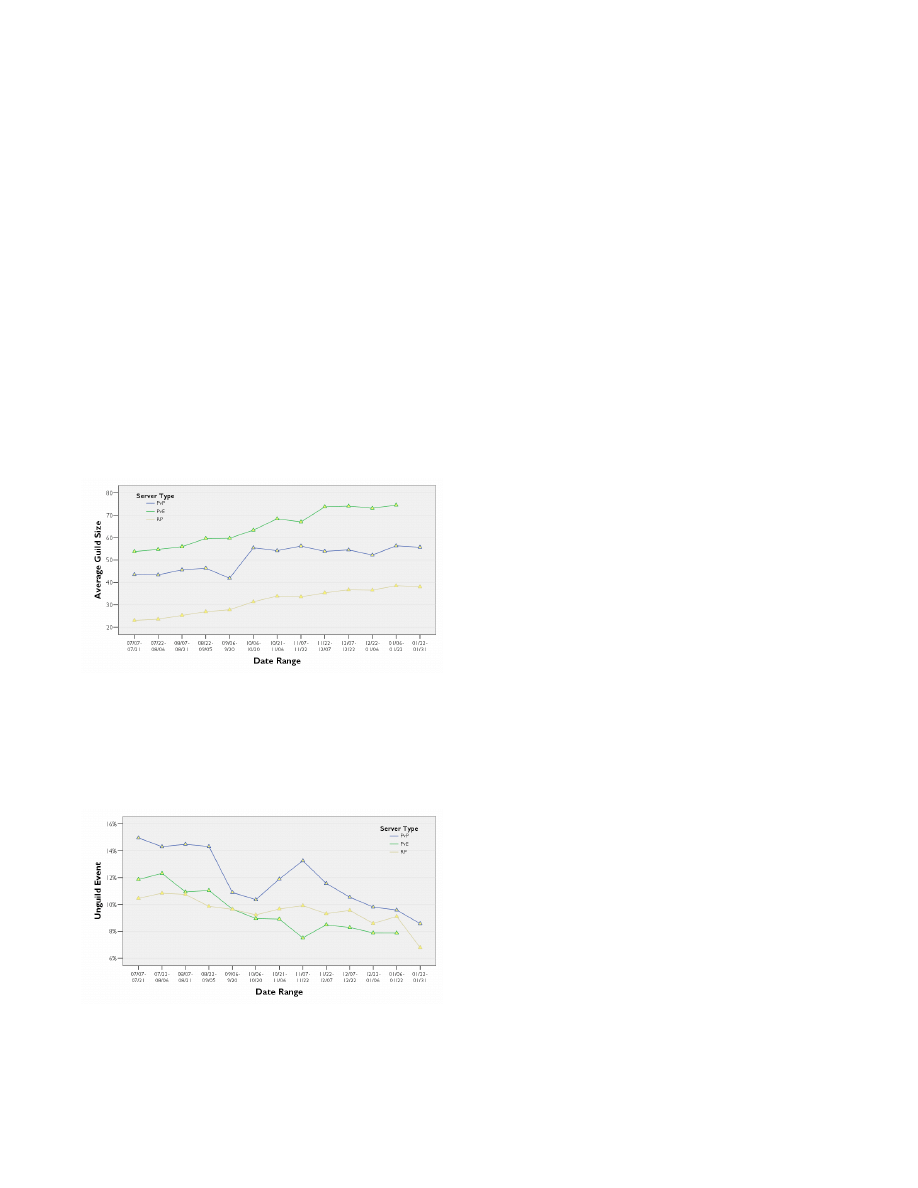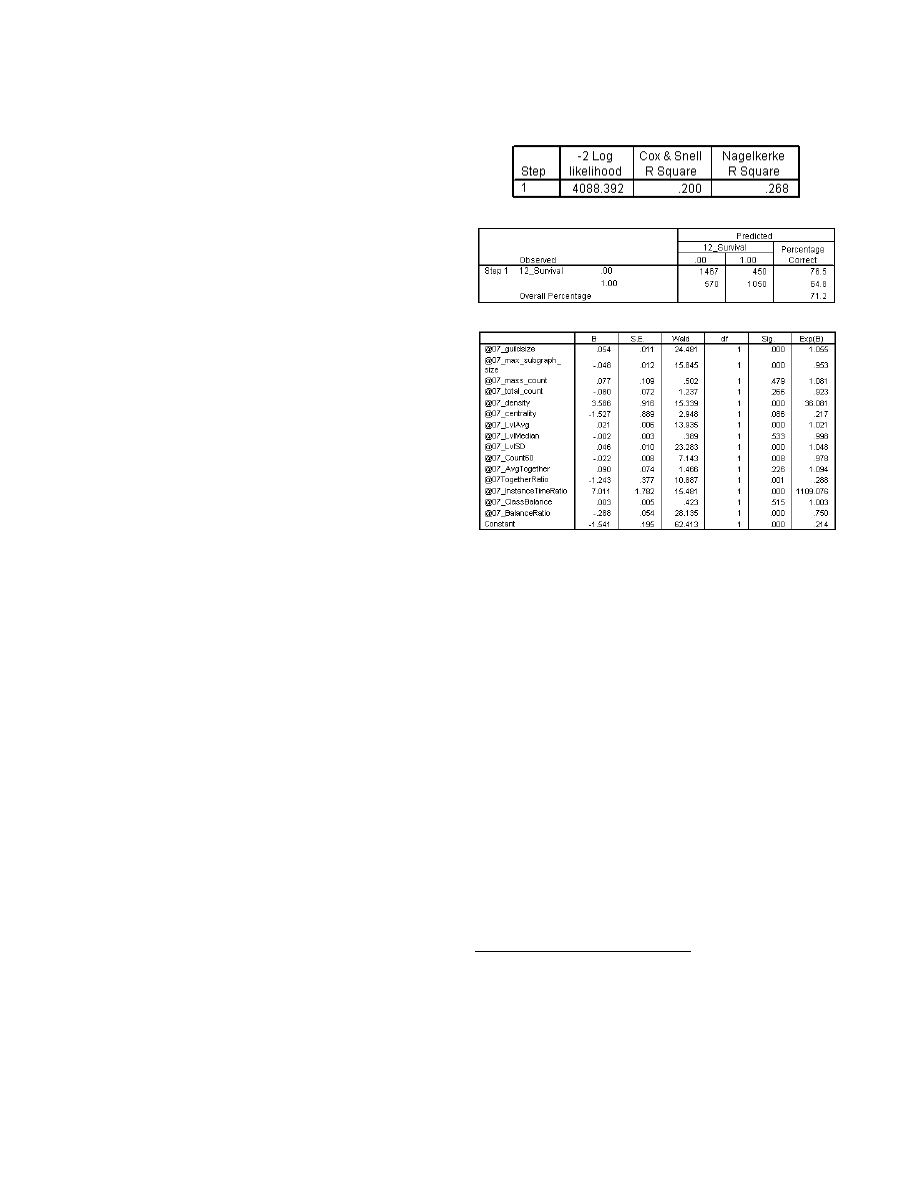
The Life and Death of Online Gaming Communities:
A Look at Guilds in World of Warcraft
Nicolas Ducheneaut
1
, Nicholas Yee
2
, Eric Nickell
1
, Robert J. Moore
1
1
Palo Alto Research Center
3333 Coyote Hill Road
Palo Alto, CA 94304 USA
{nicolas, nickell, bobmoore}@parc.com
2
Stanford University
Department of Communication
Stanford, CA 94305 USA
nyee@stanford.edu
ABSTRACT
Massively multiplayer online games (MMOGs) can be
fascinating laboratories to observe group dynamics online.
In particular, players must form persistent associations or
“guilds” to coordinate their actions and accomplish the
games’ toughest objectives. Managing a guild, however, is
notoriously difficult and many do not survive very long. In
this paper, we examine some of the factors that could
explain the success or failure of a game guild based on
more than a year of data collected from five World of
Warcraft servers. Our focus is on structural properties of
these groups, as represented by their social networks and
other variables. We use this data to discuss what games can
teach us about group dynamics online and, in particular,
what tools and techniques could be used to better support
gaming communities.
Author Keywords
Online communities, Massively Multiplayer Online Games,
social networks, group dynamics, data analysis tools
ACM Classification Keywords
H.5.3. [Collaborative Computing]: online games
INTRODUCTION
Massively Multiplayer Online Games (MMOGs) are now
hosting millions of players in their rich 3D virtual worlds.
These games are collaborative by design [23]: players often
have to band together to accomplish the game’s objectives,
and trading items and information is essential to a player’s
advancement [17]. This need for repeated collaboration
translates into formal, persistent groups that are supported
out-of-the box by nearly all MMOGs: guilds.
Guilds are essential elements in the social life of online
gaming communities. Guild members have access to simple
tools to coordinate with each other. Most commonly these
include an in-game roster showing who is currently logged
on and a private chat channel to broadcast messages to
them. Guilds frame a player’s experience [20] by providing
a stable social backdrop to many game activities, and their
members tend to group with others more often and play
longer than non-affiliated players [9]. At the “high-end” of
a game, guilds can even become indispensable: “raids”
requiring coordination among up to 40 players are essential
to advancement and it is almost impossible to assemble a
pick-up group of this size – some formal coordination
mechanisms are required, and the guilds provide such an
environment. Being a member of an “elite” or “uber” guild,
renowned for its ability to tackle the hardest challenges, is
therefore a badge of honor. Admission to these prestigious
social groups often requires going through a “trial period”,
as well as being sponsored by one of the members [23].
But overall, guilds are incredibly diverse. Some are small
groups with pre-existing ties in the physical world and no
interest in complex collaborative activities. Others are very
large, made up mostly of strangers governed by a
command-and-control structure reminiscent of the military.
In previous work, we have explored the range of
possibilities between these two extremes and documented
the motivations that lead players to guilds of one type or the
other [26]. Across all types, one trend was particularly
clear: guilds are fragile social groups, and many do not
survive very long (see also [9]).
This fragility is almost certainly due to a broad combination
of factors. Leadership style, for instance, is often cited by
players [26]. Game design is another contributor: players
“burn out” due to the intense “grind” required to advance in
MMOGs [29] and leave the game, abandoning their guild at
the same time. “Drama” (public conflict between two or
more guild members) and internal politics (e.g., arguments
over who gets access to the most powerful “loot” dropped
by monsters) have also been the demise of many guilds. All
these factors and many others have been documented in the
aforementioned previous works.
One set of factors, however, remains unexplored: the
structural properties of these groups. Indeed, many
Permission to make digital or hard copies of all or part of this work for
personal or classroom use is granted without fee provided that copies are
not made or distributed for profit or commercial advantage and that copies
bear this notice and the full citation on the first page. To copy otherwise,
or republish, to post on servers or to redistribute to lists, requires prior
specific permission and/or a fee.
CHI 2007, April 28-May 3, 2007, San Jose, California, USA.
Copyright 2007 ACM 978-1-59593-593-9/07/0004...$5.00.
CHI 2007 Proceedings • Games
April 28-May 3, 2007 • San Jose, CA, USA
839

variables influence a guild’s composition. Is it mostly made
up of high-level players or beginners? Are many classes
(e.g. warriors, priests) represented or do the members favor
a particular one? Is there any formal organization or are the
members partnering in an essentially ad-hoc fashion? The
list could go on much longer, but it is reasonable to
hypothesize that some aspects of the structure of a guild
contribute to its eventual success, just like the structure of
any organization plays a role in its efficiency [16].
To explore this aspect of the social life of guilds in more
detail we therefore decided to use data from our ongoing
study [9] of World of Warcraft (WoW), the most popular
US-based MMOG so far with more than 8 million
subscribers [6]. Our quantitative observations allow us to
compute “social accounting metrics” [5] that reflect the
structural properties of guilds and their possible impact on a
group’s survival in the long term. Our approach is inspired
by a well-established line of research at CHI that seeks to
measure the structural properties of online communities,
with the hope of eventually increasing their navigability and
the enjoyment of their members [e.g. 21, 25]. We use our
results to discuss what gaming communities can teach us
about the social dynamics of online groups, as well as the
potential for creating new tools to help understand and
manage these unique online social spaces.
METHODS
The use of quantitative data for social science research, at
CHI or elsewhere, is often criticized for ignoring the rich,
qualitative context that the metrics emerge from. Before
presenting our analyses it is therefore worth mentioning
that, as serious gamers and researchers, we have been
observing social interactions in MMOGs “from the inside”
for several years. For this paper, all the authors have
accumulated hundreds of hours of play time in World of
Warcraft, getting exposed in the process to a very broad
palette of social experiences. We have all joined guilds, big
and small, successful and doomed to failure, since the
launch of the game in November 2004. This deep, personal
experience with the game’s environment frames our
analyses and allows us to make sense of our numbers in a
contextualized manner.
Our current project and its approach was influenced in great
part by an interesting design choice made by Blizzard
Entertainment, producers of WoW. Indeed, WoW was built
such that its client-side user interface is open to extension
and modification by the user community. Thanks to this
open interface, we have been able to develop custom
applications to collect data directly from the game. For this
study we rely on WoW’s “/who” command, which lists the
characters currently being played on a given server. Our
software periodically issues “/who” requests and takes a
census of the entire game world every 5 to 15 minutes,
depending on server load. Each time a character is observed
our software stores an entry of the form:
Alpha,2005/03/24,Crandall,56,Ni,id,y,Felwood,Ant Killers.
The above represents a level 56 Night Elf Druid on the
server Alpha, currently in the Felwood zone, grouped ("y"),
and part of the Ant Killers guild. Using this application we
have been collecting data continuously since June 2005 on
five different servers: PvE(High) and PvE(Low),
respectively high- and low-load player-versus-environment
servers; PvP(High) and PvP(Low), their player-versus-
player equivalents; and finally RP, a role-playing server.
Overall we observed more than 300,000 unique characters
to date. We then used the accumulated data to compute a
variety of metrics reflecting these characters’ activities [9]
and, in particular, the structure of their guilds.
For instance, we can easily measure the observed size of
guilds (by counting the number of characters with a given
tag) and track some aspects of their membership (for
instance, by counting the number of characters of a given
level and class). We can also get a sense of the organization
of each guild by looking at their social networks. To do so,
we rely on three variables: the “zone” information, the
“grouped” flag, and finally the “guild” data. We assume
that characters from the same guild who are grouped in the
same zone are highly likely to be playing together. If so, we
create a tie between them, where the strength of the tie is
proportional to the cumulative time these characters have
spent together. We then use the accumulated data to
compute a variety of social network analysis metrics for
each character and each guild, such as their centrality and
density [24]. We also rely on visualization tools we
developed to observe the evolution of these networks and
other metrics over time (these tools are described later in
the paper).
Before going any further it is important to mention some
inherent limitations of our data. First, note that we are
collecting information about characters, not players. Players
often create several characters or “alts” (some actively
played, some acting as “mules” for storage and trading).
We believe however that this does not affect the validity of
our analyses for two reasons: 1) our observations show that
all the “alts” of a player are generally members of the same
guild; 2) except for a few “altoholics,” players tend to focus
on developing one character exclusively for a reasonably
long stretch of time instead of constantly switching between
many, simply because WoW’s design makes the latter very
unproductive – players cannot keep up with the “grind”
required to advance and fall behind the rest of their guild.
Considering that our sample periods are quite short (one
month or less, see next section), it is therefore highly
probable that each sample contains on average data limited
to a player’s current “main”, their mule, and perhaps an
additional “alt” leveled at the same time. Since we are
looking at aggregate, guild-level structural measures, not
individual patterns of behavior, this relatively uniform
spread of the number of characters played at any give time
should therefore not skew our analyses too much.
We also rely heavily on a character’s location to construct
our social networks, which is not immune to distortion. For
CHI 2007 Proceedings • Games
April 28-May 3, 2007 • San Jose, CA, USA
840

instance, characters are often left “AFK” (Away From
Keyboard) in the game’s main cities before or at the end of
a play session – their physical proximity there does not
necessarily reflect any kind of joint activity. We therefore
exclude cities from our sample when computing social
networks. It is also entirely possible for characters from the
same guild to be in the same zone and not playing together
– they could each be grouped with strangers. While this can
be a common occurrence in the “entry level” zones of the
games that are densely populated, our experience shows
this clearly tapers off as characters gain in level. We
therefore believe that, while our social networking data
might be a bit noisy and possibly creates more (or stronger)
ties between guild members than really exist, this effect is
not overwhelming.
With this in mind, we now turn to the analysis of our data.
THE DEMOGRAPHICS OF GUILDS IN WOW
Before looking at the impact of a guild’s structure on its
survival, it is worth describing some high-level properties
of these social groups – in particular, how their membership
evolves over time. This will help us characterize some of
the difficulties they face over their life cycle.
Briefly restating some data from earlier research [9], guilds
in WoW tend to be quite small: the average size is 16.8,
with a median of 9. The largest observed guild had 257
members. The 90
th
percentile of the distribution is 35, and
the distribution of guild sizes over our entire sample
follows a power law (see Figure 1) – a property shared by
many other online phenomena [13].
Figure 1 - Distribution of guild sizes
As mentioned earlier, we also know that guilds are
relatively fragile – almost a quarter of the guilds we observe
at any point in time have disappeared after a month [9]. For
guilds that survive, membership tends to be fluid. Starting
with the 6,188 guilds in our December 2005 sample, we
tabulated two rosters: a “full” roster for each guild at the
beginning of the month and a “current” roster one month
later. We repeated the procedure up to the July 2006
sample. Note that a character who is in the full roster but
not the current one is not simply a character who was not
observed towards the end of the month. For this difference
to occur, they must have “deguilded” (that is, they are not
bearing any guild tag) or joined another guild (they are
bearing a different guild tag).
Thus for each guild, the difference between those two roster
sizes is the member churn - the number of characters who
were at one point in the guild but are not there any longer.
Table 1 lists the average churn for guilds of different sizes.
The churn percentage is around 25% and fairly stable
across guilds of all sizes. In other words, if we see a guild
that currently has 20 members, then over the past month,
there were 5 members who have left the guild.
Table 1 - Mean monthly churn, by guild size
We wanted to get a sense of the pattern of migration from
guilds to one another. Also, we were interested in how often
people left guilds and whether this changed over the level
spread. For each character over a one week sample period
in August 2006 (131,984 characters), we calculated the
following variables:
1) Unguild Event - for each time a character is observed
in a guild in snapshot X but not observed to be in a
guild in snapshot X+1, we increment their unguild
event score by 1.
2) Guild Switch Event - for each time a character is
observed in a guild in snapshot X and then observed in
a different guild in snapshot X+1, we increment their
guild switch event by 1.
3) Guilded - whether a character is guilded or not at the
end of the sampling period.
Figure 2 – Unguild, switch, and guilded events across levels
We found that unguild events were far more frequent than
guild switch events and this effect magnified over the level
spread (Figure 2). Between levels 21-40, unguild events are
3 times more frequent than guild switch events (4% vs.
13%); between levels 41-60, unguild events are 7 times
more likely than guild switch events (3% vs. 21%). When
characters leave a guild, it takes them some time to find a
new home – the more so as they increase in level.
This seems to fit well with some of the guild difficulties we
mentioned earlier. After an episode of “drama”, leaders will
often forcefully remove the offending member(s) without
CHI 2007 Proceedings • Games
April 28-May 3, 2007 • San Jose, CA, USA
841

notice. Conversely, players can get so frustrated or
unsatisfied with a guild that they would rather leave and be
alone. This, combined with the fact that many guilds
require a “trial period” before accepting new members,
explains why some players can find themselves in a
prolonged interim without guild affiliation. As admission
criteria also become more stringent with rising levels, it
seems logical that unguild events would far outnumber
guild switches over the life of a character.
Of course, WoW is a dynamic world and as servers mature,
we would expect guild size and stability to change. To
assess the evolution of guilds we focused on a 6-month long
period in our data (July 2005 to January 2006), looking at
guild membership every 2 weeks (yielding about 100,000
observed characters in each 2-week sample). First, we
looked at the percentage of characters who were in guilds.
There was a mild positive increase over time. This increase
in percentage of guilded characters could mean one of two
things: there may be more guilds that spring up, or
characters are joining existing guilds. Figure 3 suggests the
latter is the case: over time, established guilds attract more
and more characters and increase in size.
Figure 3 - Average guild size over time, by server type
Over time, guilds also stabilize. As Figure 4 shows,
members are less likely to quit a guild as a server matures.
Overall, these analyses suggest that over time, characters on
a server are more and more likely to be in a guild; the
guilds they join tend to be established guilds; and over time,
guild turn-over decreases.
Figure 4 - Guild churn over time, by server type
We also looked at whether churn was different across the
server types. The data showed that member churn was
significantly and consistently higher on PvP servers than
RP or PvE servers, by about 75% to 100% (Figure 4).
Again, this seems to confirm broad trends reported
elsewhere [9, 26]. The PvP worlds are more dangerous
places, and guilds may be serving a more utilitarian
function than on other servers: if the guild fails to deliver
the required amount of protection and reward, players start
looking elsewhere. This also fits with reports that PvP
players tend to be more achievement-oriented [28] and
instrumental in their approach to group selection, as
opposed to role-players who value group life more.
Summary: consolidation and specialization
The above data reveals interesting population dynamics
within and across guilds. Overall it looks like guilds are
often in flux, but there seems to be a trend towards
consolidation where “the rich get richer”: some guilds
survive longer than others, grow in size, and attract most of
the churn from other guilds. In parallel there might also be a
trend towards specialization, with the most established
guilds focusing on specific aspects of the game (e.g. PvP,
raids) and filtering new members accordingly, which
increases the time required for players to find a new guild
when leaving another – the more so at higher levels.
This leads us to the central question of this paper: What
causes the rich to get richer in WoW? Can we explain the
survival and growth of guilds using structural variables?
THE IMPACT OF GUILD STRUCTURE
Since our software collects data from the client-side of the
game, we cannot measure the structural properties of a
guild exhaustively. Still, the “/who” command we rely on
covers a broad range of variables, and many of these could
potentially have significant impacts. We had access to the
following indicators:
•
Size: number of characters bearing a given guild tag
during the sampling period. As we saw earlier bigger
guilds tend to attract more members over time. It is
therefore reasonable to hypothesize that size has
positive impact on a guild’s evolution.
•
Density: connections between guild members can be
mapped out as a matrix. The density of a guild is the
percentage of matrix cells that are filled in. In previous
work we saw that guild social networks in WoW tend
to be very sparse [9]. We wanted to explore whether or
not guilds benefit from higher social connectivity.
•
Centrality: for each guild member, their degree
centrality is the number of connections they have
divided by the total number of connections they can
have (i.e., the guild size - 1). The guild's centrality is
the average of all of its character's centrality scores.
•
Maximum subgraph size: largest interconnected cluster
of members in a guild’s social network. This measure
gives a rough sense of how large subgroups can get
within a guild. Larger groups often experience more
CHI 2007 Proceedings • Games
April 28-May 3, 2007 • San Jose, CA, USA
842

coordination issues and overhead, which could impact
survivability and performance.
•
Mass count: the number of subgraphs larger than three
in a guild’s social network, that is, how many
independent subunits there are. Fragmentation of the
membership might create more manageable and more
successful groups within a guild, or it could impede
information sharing and be detrimental.
•
Level (average, median, and standard deviation) and
number of level 60 characters: indicators of the level of
player experience in a guild. A large number of level
60 players knowing a lot about WoW could
presumably help a guild in the long run. And overall
guilds of higher level might fare better than lower ones.
•
Average time spent together: a measure of schedule
compatibility – the higher the value, the more members
are online at the same time (we normalize this value
using each guild’s size to be able to compare them).
Schedule incompatibilities are often mentioned by
players as an important reason for leaving a guild [26].
•
Average time spent in instances: an indicator of the
importance of planned activities in a guild, as opposed
to ad-hoc quest parties.
•
Class balance: a good play group in WoW often has
representatives of different classes, since they are
highly complementary by design. We use a chi-square
score to measure overall balance or imbalance. The
chi-square score calculates the deviation of each class
count from the expected count for a given size (e.g,
there being 8 classes for each faction, a perfectly
balanced guild of 80 members would have 10 members
of each class). Bigger scores mean bigger imbalances (
we normalize the result using each guild’s size).
Having computed the above for each guild in our sample,
we then tried to assess their impact on two success
indicators for a guild: its survival, and the rate of
advancement of its members.
Guild Organization and Survival
To study guild survival, we took two month-long samples,
one from July 2005 and the other from December 2005, and
extracted all unique guilds in both. If a guild seen in the
early sample was not observed in the later one, we marked
it as "dead". Otherwise, we marked it as "survived". Using
this method, we had 3,537 unique guilds in our July sample.
Of those, 1,917 (or 54%) were not seen again in December
and marked as "dead".
We then ran a logistic regression with survival as the
dependent variable and all the metrics mentioned earlier as
predictors. The Cox & Snell R-Square for the resulting
model was .200 (Table 2) – a number that may initially
seem low but is in fact well within the accepted norms for
similar social science research [8]
1
. And again, we openly
acknowledge that our model cannot be entirely accurate
since we can only collect a limited number of variables.
Table 2 - Guild survival model summary
Table 3 - Classification table for the survival model
Table 4 - Regression coefficients for the survival model
Using a strict cut-off, the model provided by the logistic
regression was accurate in 76.5% of the "death" cases and
64.8% of the "survival" cases (Table 3) - better than chance
alone. The model identified six significant predictors of
survival (Table 4) we can rank using the Wald test. In order
of importance, we find:
•
Class balance ratio (28.135): unsurprisingly, more
balanced guilds survive better than others. More
importantly, this can also explain why churn is so high
across guilds, and why some get bigger while others
disappear entirely. Indeed, we know from previous
research that the distribution of classes over the entire
population is very imbalanced [9, 10] – priests (a
crucial healing class), for instance, are in notoriously
short supply. And therefore, their presence in one
balanced guild means class imbalance in another. The
quest for a well-balanced roster leads to churn, as
players from the needed classes are recruited away
from one guild to another (this could be especially
prevalent for guilds focusing on “endgame” content).
1
Cohen states that an R of .37 would be considered “large”
(with a corresponding R-Square value of .14), for data
collected during highly-controlled experimental conditions.
Considering that our analysis was conducted on a large
naturalistic sample with a great deal of extraneous noise, a
R-Square of .200 is therefore quite high.
CHI 2007 Proceedings • Games
April 28-May 3, 2007 • San Jose, CA, USA
843

•
Guild size (24.481): as expected, bigger guilds are
more likely to survive.
•
Level standard deviation (23.283): a wider level spread
contributes positively to survival. Our hypothesis that a
concentration of high level characters would increase
the guild’s knowledge pool, and therefore its survival,
does not seem to hold here. But an alternative
explanation could be that a wide level spread is
indicative of fresh recruits joining the ranks, replacing
natural attrition through burn-out and transfers to
competing guilds.
•
Maximum subgraph size (15.845): controlling for guild
size, guilds with smaller subgroups are more likely to
survive – perhaps because they avoid coordination
issues, as we hypothesized.
•
Time in instances (15.481): interestingly, guilds that
focus on the most complex game areas survive better.
Since these dungeons usually require more planning
and coordination than simply “roaming the world”, it
could be a reflection of a more organized guild (as
opposed to one limited to ad-hoc quest groups).
•
Density (15.339): better connected guilds apparently
survive more often than others. Anthropologists like
Dunbar [11] have proposed that a certain amount of
“social grooming” is necessary to hold a group
together. A larger number of ties might be indicative of
higher cohesion and more peer pressure to participate
in guild activities, increasing its odds of success.
While far from providing a definitive answer, these
analyses show that simple structural indicators can enrich
our understanding of group dynamics online and help
predict their long-term survival. In the context of online
game guilds, attracting a large number of members is key
but the composition and organization of this membership is
equally important. In particular, guild leaders need to make
sure that class and level spread are as broad as possible. It is
especially important to prevent the guild from becoming
“top heavy” with too many level 60 characters. As this
would be hard to achieve through chance alone, a pro-active
recruitment strategy is probably needed. Organizing
“instance runs”, as opposed to purely ad-hoc groups, also
seems to contribute positively to survival
Moreover, while guilds benefit from a dense internal social
network, the size of their largest subgroup can become a
problem. This indicates that large group activities in WoW
(e.g. 40-man raids) require significant coordination efforts
that few guilds can manage successfully. We discuss the
implications of these findings later in this paper.
Guild Organization and Player Advancement
While MMOG players join guilds for many reasons [26],
the primary motive is often game-related. A guild provides
access to shared resources, knowledge, and game partners
that can all facilitate progress through the game. The extent
to which this actually works, however, can be limited:
grouping can be an inefficient way of advancing in an
online game [9]. We explored the relationship between
guild structure and the progress of its members.
For a measure of player advancement, we computed a
standardized character advancement score. A character's
raw advancement is simply the number of levels the
character has advanced over one month (for the analyses
below, from July to August 2006). In this case, we
subtracted the starting level from the ending level. Because
a 10 level advancement by a level 1 character is much less
significant than a 10 level advancement by a level 50
character (the later stages of the game require much more
time and effort to progress), we standardized character
advancement by calculating the average (and standard
deviation) of advancement for every starting level. In other
words, we compared each character only with others who
also started at the same level at the same time. This was
done by calculating the z-score of advancement for every
character. Characters who were already level 60 at the
beginning of the sampling period were excluded.
We then computed a standardized guild advancement score
– simply the average of the standardized advancement
scores of every member in that guild. This guild score was
thus a reflection of how much the guild as a whole
advanced during the sampling period. Again, characters
who were already level 60 at the beginning of the sampling
period were excluded.
Using the same predictors as in the previous section on
guild survival, we ran a multiple regression with guild
advancement as the dependent variable. The R-Square for
the resulting model was .098 (Table 5) – smaller than
before but still within acceptable limits. The model
identified five significant predictors of character
advancement (Table 6).
Table 5 - Guild advancement model summary
Table 6 - Regression coefficients for the advancement model
In order of importance based on the standardized
coefficients we find:
CHI 2007 Proceedings • Games
April 28-May 3, 2007 • San Jose, CA, USA
844

•
Guild size (-.505): players progress faster in smaller
guilds – an interesting contrast to the earlier model.
•
Maximum subgraph size (0.470): the larger the
subgroups in a guild, the faster players advance. This is
again opposite to the survival model. But since “fast”
guilds are also smaller (see above), its is still probable
that these groups are not too large.
•
Schedule compatibility (“Together ratio”) (0.186):
perhaps unsurprisingly, guilds with members whose
time online overlaps significantly have a positive
impact on advancement – they make finding partners
for joint play sessions easier.
•
Mass count (.107): a guild fragmented into many
cohesive subunits is more beneficial to its members’
advancement. This fits well with WoW’s design: most
“quests” are designed to be challenging enough for
small groups of up to 5 players. Guilds where players
can repeatedly team with up to 4 other members of
approximately the same level (see below) should
therefore facilitate advancement.
•
Class balance (0.056): here again, a well balanced
guild has a positive effect on its members’ progress –
presumably because forming balanced and efficient
leveling groups is easier.
•
Levels standard deviation (0.056): the broader the
range of levels in a guild, the faster players progress.
This is most probably because such a spread does not
constrain players to a fixed rate of advancement. For
example, if the bulk of a guild progressed from level 25
to 30 in a given month, characters below 20 and above
35 would have trouble finding partners of the
appropriate level. A large level spread ensures that
there will always be someone in the guild with a level
close enough to play with – and this whether each
player advances faster or slower than the guild’s norm.
While some of the predictors differ from our earlier
analysis of guild survival, similar trends can also be seen. In
order to benefit their members’ progress, guilds apparently
need to be broken down into separate subgroups that cater
to different level bands, thus facilitating teaming and
leveling. Unsurprisingly, schedule compatibility is also
important: the more members’ playtime overlaps, the easier
it is to form a group and progress more quickly. But
interestingly, size does not help. On the other hand, playing
with a broader subsection of the guild (the “max subgraph”
variable) is useful, most probably because it corresponds to
having a more diverse choice of partners. There is therefore
an interesting tension between advancement and survival:
growing and partitioning a guild into small subunits
increases the group’s chances of survival, but it is less
beneficial to each individual member.
Many of the predictors we identified above and in the
previous section might sound “obvious” to long-term WoW
players – and indeed, they fit our own intuition about
successful strategies in the game fairly well. But our data
allows us to substantiate such intuitions and highlight trends
that could prove important for the design of future online
gaming communities. We now discuss the implications of
our findings in more depth.
DISCUSSION
Small Is Beautiful: Designing For Successful Gaming
Communities
Anthropologist Robin Dunbar proposed that “there is a
cognitive limit to the number of individuals with whom any
one person can maintain stable relationships” [11]. Based
on studies of the group size of a variety of primates, Dunbar
predicts that 150 is the “mean group size” for humans. This,
in turn, matches census data obtained from villages and
tribes in many cultures. But Allen argued that, online, group
size will usually plateau at a number lower than “Dunbar’s
number” of 150 [1]. Citing evidence from several online
communities (in particular another MMOG, Ultima
Online), Allen hypothesizes that the optimal size for
creative and technical groups (as opposed to exclusively
survival-oriented groups such as villages) is around 45 to
50. The data we obtained from WoW gave us the
opportunity to further test this hypothesis in the context of
gaming communities. Interestingly, our numbers are very
close to Allen’s hypothesis: most guilds in WoW have 35
members or fewer.
WoW therefore confirms that, in games as in other online
social spaces, mass collective action can be difficult to
achieve. Returning to Dunbar, this difficulty could be due
to limited “social grooming” [11], that is, repeated
interactions between the members of a guild. As we saw
above, a number of simple game design factors conspire
against the formation of cohesive subgroups in guilds -
schedule incompatibilities, level gaps, class imbalances, etc.
As a result social networks in guilds tend to be sparse, and
it is well known that when the likelihood of two individuals
working together again is low, people tend to behave
selfishly [2] – and leave. Such trends can be exacerbated
where individuals self-select for achievement and an
instrumental orientation to online play: as we saw, churn is
highest on PvP servers.
It has been argued before that online communities (Usenet
newsgroups for instance) can favor the emergence of very
large groups [15], because the medium itself reduces the
costs of communication and coordination, but online games
like WoW are almost the antithesis of these pioneering
online social groups in this respect. In particular, WoW
exacerbates the challenge of finding people with similar
interests: no information is readily available about the
makeup of a guild, its collective interests, its needs for new
members of particular levels and classes, etc. Most of this
information is traded out-of-game (if at all) on forums that
are not visited by all players. Yet our analyses show that
simple variables could be used to better match players to
CHI 2007 Proceedings • Games
April 28-May 3, 2007 • San Jose, CA, USA
845

guilds: for instance, making each guild’s roster publicly
visible in-game could go a long way.
Some online game designers seem to have taken notice.
Subscribers to Sony Online Entertainment’s (SOE)
Everquest II can get access to dedicated tools to publish
information about their guilds on SOE’s web site –
provided they pay an additional fee for the “premium”
service. Considering the importance of such information for
the long-term health of guilds, we would argue that online
games would benefit from providing such a service in-game
and for free.
Guilds in WoW are also susceptible to a form of “tragedy
of the commons” against which previous online
communities had developed rules and institutions [15]. In
particular, leaving a guild has no cost to the player: typing
“/gquit” is enough to remove oneself from the group. As
such, nothing prevents players from leaving a guild as soon
as their personal objectives are accomplished. To be sure,
high-level players who behave selfishly will tarnish their
reputation and news travels fast on a WoW server,
decreasing their chances of finding a new group. Still, no
mechanisms are in place to build up a player’s attachment
to his/her guild, which probably encourages churn. But here
again we see signs of interesting design changes: in City of
Heroes, another MMOG produced by NCSoft, guild
(“supergroup”) members are expected to play in “SG
mode,” which means that they receive fewer “influence”
(in-game currency) points for their actions because part of
the influence is converted to “prestige,” the guild currency,
for the guild’s use. Here membership is actually exacting a
definite cost, which should make the boundaries of a guild
less porous and potentially reduce free-riding.
Another worrying trend emerging from our data is that
guilds seem to have a tendency towards entropy over the
long run. Groups get larger and larger, monopolizing the
most-needed players and concentrating the game’s most
coveted rewards in the hands of a few. This has the
potential to negatively impact playability over time, in two
opposite ways illustrated by our data: large guilds can
become “top-heavy” and susceptible to burn-out; new
players can have a harder time progressing since few
groups are available to cater to their needs. The difficult
issue seems to be to encourage “healthy” levels of churn
that prevent guild stagnation yet do not threaten their
survival and growth.
Overall, WoW is a fascinating example of group dynamics
in an online environment with little to no support to group
formation and coordination. It is interesting to note that
WoW’s designers may have overestimated the size that a
group can reach organically under these conditions: the 90
th
percentile for guild size, 35, falls just short of what is
required to access the game’s toughest (and most
rewarding) content: 40-player raids. As such, a very large
number of players cannot enjoy a substantial portion of the
game, simply because they cannot grow a group to the
necessary size (a problem we explore in more depth in
[10]). When designing group activities in online games,
short of providing an extensive set of tools to support large
social units, the best principle might therefore be that
“small is beautiful” [19] – a somewhat ironic conclusion for
massively multiplayer environments with millions of
subscribers. Blizzard seems to have adopted a similar view:
the majority of new high-end dungeons they recently added
require only 10- or 20-player groups, well within the reach
of a 35-members guild.
A Social Dashboard for Managing Gaming Communities
As we mentioned above, games like WoW provide few
tools out-of-the-box to facilitate the large-scale,
collaborative activities MMOGs are famous for. Yet
monitoring simple variables, like the ones we used in our
models, could help identify some important problems in
groups. Both players and game managers could benefit
from tools to track group-survival metrics: the former could
adapt their guild’s recruitment strategy to increase their
chance of success in game, and the latter could monitor the
health of guilds across an entire server to assess the impact
of their game’s design on collaboration.
Inspired by similar efforts focused on other online
communities [e.g. 18, 22], we developed a prototype Social
Dashboard to visualize and explore the guild survival
metrics we described earlier. We have used this tool
internally in our research, and hope to release it to players
and game designers alike in the near future. We present it
below as a simple example of what could be done when
mining social interaction data from online games.
The Social Dashboard’s main screen presents an overview
of some key guild survival metrics (only three are shown in
Figure 5: guild size, density, and number of subgroups) for
an entire game server. Each gauge clearly indicates
“dangerous” and “critical” thresholds for each variable,
based on the models we described earlier. This gives the
user (here most probably a community manager) a sense of
the most important areas to address – on this particular
server for example, guilds are too small.
Figure 5 - The Social Dashboard's main screen
To understand the problem in more detail, the user can click
one of the gauges to access a report on the evolution of the
metric over a given time period (in Figure 6, over a month).
Aggregate values for the entire server are available (the
CHI 2007 Proceedings • Games
April 28-May 3, 2007 • San Jose, CA, USA
846

blue lines – light blue are daily values, dark blue is a mobile
mean over seven days), as well as specific data for any
given guild on the server (the dark lines). Guilds can be
selected from the complete list to the right or from pre-
computed short lists of groups that have passed the
“dangerous” or “critical” thresholds for this metric (in the
example above, the selected guild’s size has been
collapsing over the past month and just dipped below the
survival threshold, represented by the dotted green line).
Figure 6 - Evolution of a survival metric over time
Finally, the user can explore which factors in the guild’s
composition and organization might have contributed to the
problem identified earlier. The Social Dashboard can
display the evolution of a guild’s social network over time
(Figure 7), allowing the user to observe the changing roles
of veteran guild members and newcomers alike, as well as
the impact of members leaving. The network displays
additional information relevant to guild survival, such as a
player’s class and level. Various components of the
network can be isolated using standard simplification
techniques (e.g., eliminate nodes based on degree or
strength of ties)
2
.
Figure 7 - Social network for a guild early in the month
2
We use a deterministic layout algorithm to ensure the
position of each player in the network remains the same
from one analysis session to the next. Our dynamic network
visualization package was implemented on top of the
Prefuse toolkit [12]; the algorithm itself was inspired by the
Kamada-Kamai layout [14] used in the SoNIA project [4].
Learning Teamwork From Games
As we saw earlier, successful guilds in WoW are both big
and divided into multiple, small subgroups (around 6
players per subgroup for most, see [9]). From the
perspective of organization theory, successful guilds are
therefore organic, team-based organizations [7]. This fits
the game environment well: most tasks require small groups
(5 participants for most quests) with complementary skills
and similar levels (if the gaps between levels in a group
exceeds 10, the higher-level participants do not earn
“experience points”). Guilds provide the opportunity for
forming such cohorts that will progress through the game at
the same pace. But in parallel, the overall size of the guild
provides access to resources that could not be obtained
otherwise. In a large guild, players can specialize in crafting
special items for other players, getting other items in
returns. The larger the guild, the more this specialization
makes sense – in other words, guilds reduce transaction
costs [27]. Getting information and help from guildmates is
also generally easier than asking random strangers. As such,
the exchange of information and resources provides an
incentive for joining a large guild, while the structure of in-
game activities encourages small teams.
These findings are particularly interesting in light of the
recent debate about the educational value of games that are
not originally designed with the teaching of specific skills
in mind. For instance, it has been argued that the “video
game generation” is acquiring valuable knowledge from
games that will help them transform the workplace [3]. Our
observations indicate that MMOGs like WoW certainly
familiarize their players with organizational forms that are
prevalent in today’s work environment. Players are also
given clear roles (their class) that naturally steer them into
specific positions in their guild’s social network. This may
later affect the way these players behave in the workplace
(for instance, WoW players might prefer working in small
teams with clearly-defined individual responsibilities). The
relationship between online games and “real world”
behavior in organizations is clearly an opportunity for
future research.
CONCLUSION
Online games can be fascinating laboratories to observe the
dynamics of groups online. In games as in other online
social spaces, growing and sustaining large communities
can be quite difficult. Our findings reinforce earlier
research showing that there might be a hard limit on the
size of a viable organic group online, possibly set at around
35 group members or less. This has important implications
for the design of current and future games, since most
require players to form substantially larger social units that
might be unsustainable without additional support.
Somewhat surprisingly, games like WoW do not offer
much collaboration infrastructure to their player
associations, despite years of research on cooperation and
conflict online. If players had access to simple data to
evaluate a guild’s profile, a great deal of churn could
CHI 2007 Proceedings • Games
April 28-May 3, 2007 • San Jose, CA, USA
847

possibly be avoided. We presented one tool we designed to
address this problem, the Social Dashboard – but much
more could be done.
Still, some guilds manage to optimize aspects of their
organization to increase their chances of growth and
survival. While our data is inherently limited and we
believe more factors are at play, our analyses show that
simple models can help isolate some beneficial structural
properties for a guild. In WoW, this means simultaneously
growing a guild while partitioning the members into small,
balanced subgroups (in terms of class and levels) that are
best suited to doing quests and other activities. The guild
itself serves as a broader social environment where
resources and services can be exchanged. This “optimal”
organization is a direct consequence of WoW’s design and
might not sound surprising to veteran players. Still, we have
been able to show that there is apparently little room to
deviate from these built-in constraints. This, in turn, steers
the players towards certain forms of teamwork that might
transfer to group activities outside of games. Such data is
particularly relevant in light of current debates about the
educational value of MMOGs and their possible impact on
the workplace.
ACKNOWLEDGEMENTS
The authors would like to thank Cabell Gathman for her
insightful comments on early drafts of this paper.
REFERENCES
[1] Allen, C.: The Dunbar number as a limit to group sizes.
http://tinyurl.com/e3t8w.
[2] Axelrod, R.: The evolution of cooperation. Basic Books,
New York (1984)
[3] Beck, J.C.,Wade, M.: Got game: How the gamer
generation is reshaping business forever. Harvard Business
School Press (2004)
[4] Bender-deMoll, S.,MacFarland, D.A.: The art and
science of dynamic network visualization. Journal of Social
Structure, 7 (2). (2006)
[5] Bernheim Brush, A.J., Wang, X., Combs Turner,
T.,Smith, M.A.: Assessing differential usage of Usenet
social accounting meta-data. In: Proceedings of CHI 2005,
ACM, New York, (2005), 889-898
[6] Blizzard: January 11, 2007 press release.
http://www.blizzard.com/press/070111.shtml.
[7] Burns, T.,Stalker, G.M.: The management of
innovation. Tavistock Publications, London (1961)
[8] Cohen, J.: Statistical power analysis for the behavioral
sciences (2nd ed.). Lawrence Erlbaum Associates,
Hillsdalle, NJ (1988)
[9] Ducheneaut, N., Yee, N., Nickell, E.,Moore, R.J.:
"Alone Together?" Exploring the social dynamics of
massively multiplayer online games. In: Proceedings of
CHI 2006, ACM, New York, (2006), 407-416
[10] Ducheneaut, N., Yee, N., Nickell, E.,Moore, R.J.:
Building a MMO with mass appeal: a look at gameplay in
World of Warcraft. Games and Culture, 1 (4). (2006) 1-38
[11] Dunbar, R.I.M.: Coevolution of neocortical size, group
size and language in humans. Behavioral and brain
sciences, 16 (4). (1993) 681-735
[12] Heer, J., Card, S.K.,Landay, J.A.: Prefuse: a toolkit for
interactive information visualization. In: Proceedings of
CHI 2005, ACM, New York, (2005), 421-430
[13] Huberman, B.A.: The laws of the Web: patterns in the
ecology of information. MIT Press, Cambridge, MA (2001)
[14] Kamada, K.,Kawai, S.: An algorithm for drawing
general undirected graphs. Information processing letters,
31. (1989) 7-15
[15] Kollock, P.,Smith, M.A.: Managing the virtual
commons: cooperation and conflict in computer
communities. In: Herring, S. (ed). Computer mediated
communication, John Benjamins Publishing Company,
Philadelphia, PA, (1996)
[16] Mintzberg, H.: The structuring of organizations.
Prentice Hall (1978)
[17] Nardi, B.,Harris, J.: Strangers and Friends:
Collaborative Play in World of Warcraft. In: Proceedings of
CSCW 2006, ACM, New York, (2006)
[18] Sack, W.: Conversation Map: An interface for very
large-scale conversations. Journal of Management
Information Systems, 17 (3). (2001) 73-92
[19] Schumacher, E.F.: Small Is Beautiful: Economics As If
People Mattered. Blond & Briggs Ltd., London (1973)
[20] Seay, A.F., Jerome, W.J., Lee, K.S.,Kraut, R.E.:
Project Massive: A study of online gaming communities.
In: Proceedings of CHI 2004, ACM, New York, (2004),
1421-1424
[21] Smith, M.A.: Measures and maps of Usenet. In: Lueg,
C.,Fisher, D. (eds.) From Usenet to Cowebs: Interacting
with Social Information Spaces, Springer, Berlin, (2003),
47-78
[22] Smith, M.A.,Fiore, A.T.: Visualization components for
persistent conversations. In: Proceedings of CHI 2001,
ACM Press, NY, Seattle, WA, (2001), 136-143
[23] Taylor, T.L.: Play between worlds. The MIT Press,
Cambridge, MA (2006)
[24] Wasserman, S.,Faust, K.: Social network analysis:
methods and applications. Cambridge University Press,
Cambridge, UK (1994)
[25] Whittaker, S., Terveen, L., Hill, W.,Cherny, L.: The
dynamics of mass interaction. In: Proceedings of CSCW
1998, November 14 - 18, 1998, Seattle, WA USA, (1998),
257-264
[26] Williams, D., Ducheneaut, N., Xiong, L., Zhang, Y.,
Yee, N.,Nickell, E.: From treehouse to barracks: The social
life of guilds in World of Warcraft. Games and Culture, 1
(4). (2006) 338-361
[27] Williamson, O.E.,Masten, S.E.: The Economics of
Transaction Costs. Edward Elgar (1999)
[28] Yee, N.: The Daedalus Gateway.
http://www.nickyee.com/daedalus.
[29] Yee, N.: The labor of fun: How video games blur the
boundaries of work and play. Games and Culture, 1. (2006)
68-71
CHI 2007 Proceedings • Games
April 28-May 3, 2007 • San Jose, CA, USA
848
Wyszukiwarka
Podobne podstrony:
Jakobsson, The Life and Death of the Medieval Icelandic Short Story
The Life and Death of Rasputin written by Vladimir Moss (a booklet)
Sterne The Life and Opinions of Tristram Shandy, Gentleman
A Son of God The Life and Philosophy of Akhnaton, King of Egypt
The life and works of Oscar Wilde
Devi Savitri A Son Of God The Life And Philosophy Of Akhnaton, King Of Egypt
The life and times of Ambrosius Aurelianus
Manly P Hall The Life and Teachings of Thoth Hermes Trismegistus
Not the Life and Adventures of Sir Roger Bloxam
The Life and Letters of Dr Samuel Hahneman1
The Life and Career of William Paulet (C David Loades
Polanyi Levitt the english experience in the life and work of Karl Polanyi
Becker The quantity and quality of life and the evolution of world inequality
Cho Chikun's encyclopedia of life and death part three a
Cho Chikun's encyclopedia of life and death part one ele
A Matter of Life and Death By Derdriu oFaolain
Paul Hollander Political Will and Personal Belief, The Decline and Fall of Soviet Communism (1999)
Life and Legend of Obi Wan Kenobi, The Ryder Windham
więcej podobnych podstron